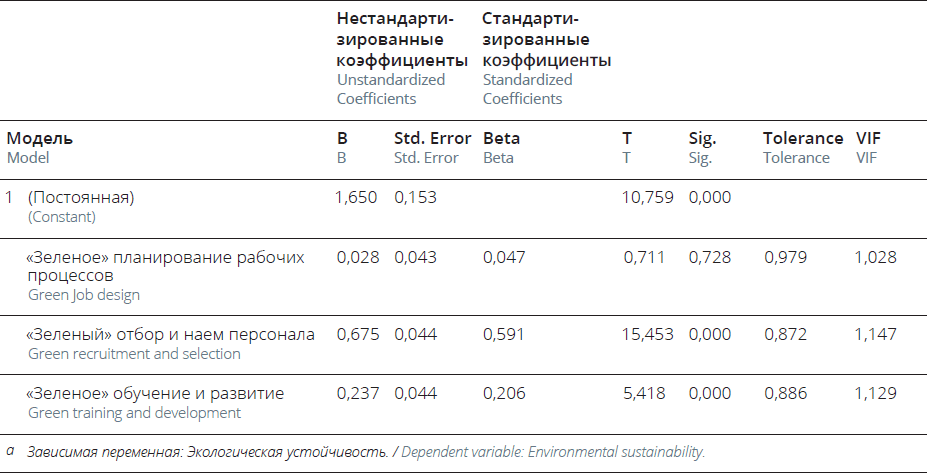 полная версия
полная версияПозитивные изменения. Том 2, №4 (2022). Positive changes. Volume 2, Issue 4 (2022)
Bangwal et al. (2017) examined GHRM, work-life and environmental performance through direct and indirect effect of GHRM practices. Structural equation modeling (SEM) was used to analyze the data from 365 employees of Leadership in Energy and Environmental Design (LEED)-certified companies. The study found significant positive direct effect of GHRM practices on environmental performance. More so, Gill et al. (2021) studied the effect of GHRM on environmental performance through the role of employee eco-friendly. Multiple regressions technique and structural equation modeling were used for analysis. The study indicates that organizational GHRM has positive and significant effect on environmental performance. Singh and Shikha (2015) analyzed the impact of green human resource factor on environmental performance in manufacturing firms. Linear regression was employed to test the hypotheses. The result indicated significat and positive relationship between top management commitment, employee environmental training and green program on environmental performance.
It is worth noting that none of the studies reviewed included green job design and analysis, which entails integrating environmental sustainability related tasks, duties and responsibilities into each job. This has created a substantial gap.
METHODOLOGYThe study adopts the descriptive survey research design since the researcher has no control of the variables and no intention to manipulate any of them. The study population comprised 674 employees of DMBs in the three major towns of the three senatorial zones in Katsina State. Namely, Daura town, Katsina metropolis and Funtua town in North Senatorial Zone, Central Senatorial Zone and South Senatorial Zone (Saifullahi et al., 2016) respectively. Primary data was collected via structured questionnaires with closed-ended statement based on 5-point Likert scale that range from 1 (strongly disagree) to 5 (strongly agree). The questionnaire for green job design was formed from Bombiak (2019) list of green practices at each stage of the HR function, while the other GHRM and environmental sustainability practices were adapted from a scholarly study by Mandago (2019). Out of the 672 questionnaires distributed, 420 were validly completed and returned, while multiple regression was used to analysis the data collected.
Cronbach's Alpha coefficient was used to assess the reliability of the instrument of the study so as to ensure consistency of the measurement. Instruments with a Cronbach's alpha coefficient of 0.7 and above were considered reliable and suitable for the study. The hypothesis of the study was tested at 5 % level of significance (alpha, α = 0.05). If the p-value was greater than or equal to alpha (p-value ≥ 0.05), the null hypothesis was accepted. However, a p-value less than the alpha (p-value < 0.05) meant the null hypothesis was rejected.
The model for the study is expressed thus:
ES = β0 + β1 GJDA + β2 GRS + β3 GTD + µ (1)
Where: ES = Environmental Sustainability; β0 = the intercept (constant); β1 = coefficient of Green job design and analysis; β2 = coefficient of Green recruitment and selection; β3 = coefficient of Green training and development.
GJDA = Green job design and analysis;
GRS = Green recruitment and selection practices; GTD = Green training and development practices; while µ = the error term.
RESULTS AND DISCUSSION
This section presents the results of the analysis conducted using SPSS software, the summary of which is contained in Table 1, 2 and 3.
Table 1. Reliability Statistics

Table 2. Model Summary

Table 3. Coefficients

The reliability test in Table 1 shows that the five variables have Cronbach's alpha coefficient above 0.70, which according to Hair et al. (2010) is considered the minimum acceptable level.
REGRESSION RESULTS
A regression analysis was conducted by regressing environmental sustainability on GJD, GRS and GTD via multiple regression model.
Table 2 shows the R square of 0.467, signifying that 46.7 per cent of variations in environmental sustainability are explained by the predictors vis-à-vis GJD, GRS, and GTD. The Table further shows F-statistic of 121.333 and its associated P-value of 0.00 which is statistically significant at 0.001. This is a confirmation that the joint estimated coefficient of GJD, GRS, and GTD are statistically significant on environmental sustainability. Also, Table 2 shows the Durbin-Watson Statistics of 1.914, which confirms nonautocorrelation of errors.
Similarly, the Variance Inflation Factor (VIF) in Table 3 are 1.028, 1.147 and 1.129 for GJD, GRS, and GTD with associated tolerance statistics of 0.979, 0.872 and 0.886 respectively. The VIF are well below 5.0 and the tolerance statistics are above 0.2, which means there is no collinearity problem in this model. According to Hair et al. (2011) VIF above 5 is an indication of collinearity concern. While Field (2009) is of the view that tolerance statistics below 0.2 indicate serious problems. The study's VIF and tolerance statistics are within the acceptable limits.
HYPOTHESIS ONE
H01: Green job design and analysis have no significant effect on environmental sustainability.
Table 3 shows that green job design and analysis has no significant effect on environmental sustainability as validated by the P-value of 0.728 which is greater than 5 per cent level. The study, therefore, failed to reject the null hypothesis one (H01) and concluded that GJD has no significant effect on environmental sustainability.
HYPOTHESIS TWO
H02: Green recruitment and selection practice have no significant effect on environmental sustainability.
Table 3 reveals a p-value of 0.001 which is less than 5 per cent level. This means green recruitment and selection practice have significant effect on environmental sustainability. The study therefore rejects the null hypothesis two (H02) and concluded that GRS practice has significant effect on environmental sustainability. This study confirms studies conducted by Jehan et al. (2020), Muhammad et al. (2019), Owine and Kwasira (2016), which indicates that GRS have significant effect on environmental sustainability.
HYPOTHESIS THREE
H03: Green training and development practice have no significant effect on environmental sustainability.
Table 3 indicates that green training and development practice have significant effect on environmental sustainability as indicated by a p-value of 0.01 level (i.e. p < 0.01), which is statistically significant. The study, therefore, rejects the null hypothesis and concluded that GTD practice have significant effect on environmental sustainability. Finding of this study validates those of Bangwal et al. (2017), Gill et al. (2021), Mandago (2019), Mobarez (2018), Rawashdeh (2018), and Zhao et al. (2020) which reveal that GTD have significant effect on environment sustainability.
DISCUSSIONS OF FINDINGSThe study's aim was to evaluate the effect of GHRM practices on environmental sustainability via GJD, GRS and GTD. Findings of this study shows that GJD has no effect on environmental sustainability, while GRS and GTD have statistically significant effect on environmental sustainability of DMBs in Katsina State. It will therefore be safe to state that GJD of DMBs in Katsina State has no green elements that would contribute to the sustainability of the environment. Meanwhile, GRS and GTD have a significant positive effect on the environmental sustainability, since these practices incorporate environmentally friendly activities like online job application and recruitment, computerization of recruitment and selection processes, which discourage the use of paper and travelling for exams and interviews. More so, the banks hold online training for staff; train their employees on environmental safety and health, and on the use of energy efficient equipment and facilities in the banks. All these are efforts to discourage environmental hactivities that are harmful to the environment and create safe and healthy workplace. The findings on GRS, and GTD confirm the findings by Bangwal et al. (2017), Gill et al. (2021), Mandago (2019), Mobarez (2018), Rawashdeh (2018), and Zhao et al. (2020) which established that GRS and GTD have significant effect on environmental sustainability.
CONCLUSION AND RECOMMENDATIONSThe study evaluated the effect of green human resources management practices which is predicated by GJD, GRS, and GTD. Descriptive research design was employed, and structured questionnaires were administered to 672 respondents; however, only 420 questionnaires were validly completed and used for the analysis. Regression result revealed the p-value of 0.728, 0.001 and 0.001 for GJD, GRS, and GTD respectively. Based on these findings, the following conclusions are made:
1. GJD has insignificant effect on environmental sustainability of DMBs In Katsina State, because the p-value is well above 5 %.
2. GRS practice of MDBs in Katsina State shows a positive and statistically significant effect on environmental sustainability at a p-value of 0.001.
3. The p-value of 0.001 for GTD practice of MDBs in Katsina State indicates a positive and statistically significant effect on environmental sustainability.
In line with the study's findings and resulting conclusions, the study recommended that:
1. DMBs in Katsina State should collaborate with their headquarters to review their job design and analysis to include at least one element of green practice and green working structure as a duty and designed environment for their employees. By so doing they will be creating green consciousness in their employees.
2. The banks should make their GRS practices more sustainable and include knowledge of environmental sustainability in their job criteria so as to attract those that are green conscious and brand themselves as environmentally friendly organization.
3. DMBs should just like other sustainability elements (economy and social) make well defined policies on environment sustainability and incorporate in all their human resource practices.
4. DMBs should treat the environmental sustainability issues all seriousness it desire, since by so doing they will be maximizing this non-financial value to a broader range of stakeholders.
REFERENCES1. Abaje, I. B., Onu, V., Abashiya, M., Oyatayo, K. T., Ibrahim, A. A., Ati, O. F. & Sawa, B. A. (2017). Climate Change Vulnerability Assessment in Northern Part of Katsina State, Nigeria: A quantitative approach. Dutse Journal of Pure and Applied Science (DUJOPAS), 3(1)1–14.
2. About Stakeholder Theory. (2018). Retrieved from: http://www.stakeholdertheory.org/ about. (accessed 22.12.2020).
3. Adesola, M. A., Yahaya, Y. & Abodunde, S. M. (2021). An Exploratory Study of Green Human Resource Management and Environmental Performance of Nigerian Manufacturing Companies. Indiana Journal of Humanities and Social Sciences, 2(7), 50–57. Retrieved from: https:// indianapublications.com/Journals/IJHSS. (accessed 10.12.2022).
4. Ali, H. H. & Wael, L. S. (2018). Impact of Green Human Resource Management on Employee Behaviour. Journal of Applied Business Research, 6(1), 18–34.
5. Bangwal, D., Tiwari, P. & Chamola, P. (2017). Green HRM, Work-Life and Environment Performance. International Journal of Environment Workplace and Employment 4(3), 244–268. DOI: 10.1504/ IJEWE.2017.10008697.
6. Bangwal, D., Tiwari, P. (2015). Green HRM – A Way of Greening the Environment. IOSR Journal of Business Management (IORS-JBM) 17(12), 45–53. DOI: 10.9790/487X-171214553.
7. Bhasin, H. (2020, October 6). Marketing91. Retrieved from: https://www.marketing91. com. (accessed 22.12.2020).
8. Bombiak, E. (2019). Green Human Resource Management – The Latest Trend Or Strategic Necessity? Journal of Entrepreneurship and Sustainability Issues, 6(4), 1647–1662. http://doi.org/10.9770/ jesi.2019.
9. Briggs, H. (2017, May 31). Science & Education. Retrieved from: http://www.bbc. com. (accessed 24.11.2020).
10. Cohen, E., Taylor, S., & Muller-Camen,
M. (2012). HRM's Role in corporate social and environmental sustainability. USA: SHRMFoundation.org. Retrieved from: https://www.shrmf.org. (accessed 10.12.2022).
11. Committee of Nigerian Sustainability Banking Principles. (2019). Sustainability in the Nigerian Banking Industry: The Journey So Far (2012–2018).
12. Deloitte West Africa (2017). Sustainable Banking as a Driver for Growth: A Survey of Nigerian Banks. Retrieved from: https://www2.deloitte.com/za/en/nigeria/pages/strategy/articles/sustainable-banking-as-a-driver-for-growth-a-survey-of-nigerian-banks.html. (accessed 10.12.2022).
13. Diri, T. V. & Otekenari, D. E. (2021). Green Human Resource Management: A Catalyst for Environmental Sustainability in Nigeria. Journal of Global Ecology and Environment, 9–27.
14. Edeh, O. F. & Okwurume, N. C. (2019). Green Human Resource Management and Organizational Sustainability of Money Deposit Banks in Nigeria. Journal of Management Sciences, 224–235.
15. Ezeabasili, N. (2009). Legal Mechanism For Achieving Environmental Sustainability in Nigeria. African Research Review, 3(2), 368380. Retrieved from: http://www.ajol.info. (accessed 29.11.2020).
16. Field, A. P. (2009). Discovering Statistics using SPSS.
17. Gharibeh, M. (2019). The Impact of Green Human Resource management Practices (GHRMP) on Competitive Advantage of Organization. Journal of Social Sciences, 8(4), 630–640.
18. Gill, A. A., Ahmad, B., & Kazmi, S. (2021). The Effect of Green Human Resource Management on Environmental Performance: The Mediating Role of Employee Eco-Friendly Behavior. Management Science Letters, 1726–1734. Doi:10.5267/j.msl.2021.010.
19. Guerci, M. D., Luzzini, A. & Longoni (2015). Translating Stakeholder Pressures into Environmental Performance – the Mediating Role of Green HRM Practices. The International Journal of Human Resource Management. DOI:10.1080/09585192.201 5.1065431.
20. Hadjri, M., Perizade, B., Zunaidah, & Farla, W. (2019). Green Human Resource Management, Green Organizational Culture, and Environmental Performance: An Empirical Study. DOI: 10.2991/ icoi-19.2019.25.
21. Hair, J., Black, W., Babin, B., & Anderson, R. (2010). Multivariate data analysis (7th ed). Upper Saddle River, New Jersey: Pearson Educational International.
22. Hair, J., Ringle, C., & Sartedt, M. (2011). PLS-SEM: Indeed a Silver Bullet. The Journal of Marketing Theory and Practice, 19(2), 139151. DOI: 10.2753/MTP1069–6679190202.
23. Ibrahim, S. S., Ibrahim, A., Allah, A. N., & Saulawa, L. A. (2016). Building of a community cattle ranch and radio frequency identification (RFID) technology as alternative methods of curtailing cattle rustling in Katsina State. Pastoralism, 6(1), 1–9. DOI 10.1186/s13570–016–0055-z.
24. Ibrahim, Y. E. (2018). Climate Change: Threats and Opportunities in Katsina State, Nigeria. Conference session Faculty of Natural and Applied Sciences Colloquim/ Seminar Series at Umaru Musa Yaradua University, Katsina, Nigeria.
25. Jabbour, C. (2013). Evironmental Training in Organizations: From a literature review to a framework for future research. Resources, Conservation and Recycling, 74, 144–155. https://doi.org/10.1016/j. resconrec.2012.12.017.
26. Jackson, S. E., Renwich, D. W. S.; Jabbour, C. J. C. & Muller-Camen, M. (2011). State of the Art and Future Directions for Green Human Resource Management: Introduction to the special issue. German Journal of Human Resource Management, 25(2), 99–116. https://doi.org/10.1177/2397 00221102500203.
27. Jehan, Y., Hussai, D., Batool, M. & Imran, M. (2020). Effect of Green Human Resource Management Practice and Environmental Sustainability. International Journal of Human Capital in Urban Management, 5(2), 153–164. DOI:10.22034/ IJHCUM.2020.02.06.
28. Langat, B. & Kwasira, J. (2016). Influences of green human resource management practices on environmental sustainability at Kenyatta University, Kenya. International Journal Of Economics, Commerce and Management, 4(10), 986–1003.
29. Liu, W. (2010). The Environmental Responsibility of Multinational Corporation. Journal of American Academy of Business, 81–88.
30. Mandago, J. R. (2019). Influence of Green Human Resource Management Practices on Environmental Sustainability in Service Based State Corporations in Kenya. [Doctoral dissertation, Jomo Kenyatta University of Agriculture and Technology]. Digital Repository.
31. Mandip, G. (2012). Green HRM: People Management Commitment to Environmental Sustainability. Research Journal of Recent Science, 1, 244–252.
32. Mathapati, C. M. (2013). GREEN HRM: A Strategic Facet. Tactful Management Research Journal, 2(2), 1–6.
33. Mobarez, A. A. (2018). The Effect of Green Human Resource management on Organization's Sustainable Environment Performance (Emprical Study). Journal of the Association of Arab Universities for Basic and Applied Sciences, 1–29. Retrieved from: https://www.researchgate. net/publication/33167421. (accessed 12.12.2020).
34. Opatha, H. (2014). Green Human Resource Management: Simplified General Reflections. International Business Research, 7(8), 109–110. DOI: 10.5539/ibr.v7n8p101.
35. Owine, W. A., & Kwasira, J. (2016). Influence of Selected Green Human Resource Management on Environmental Sustainability at Menengai Oil Refinery Limited, Nakuru, Kenya. Journal of Human Resource Management, 4(3), 20–27. DOI: 10.11648/j.jhrm.20160403.11.
36. Ramasamy, A., Inore, I. & Sauna, R. (2017). A study on implications of implementing Green HRM in the corporate bodies with special reference to developing nations. International Journal of Business and Management, 12(9), 117. DOI:10.5539/ ijbm.v12n9p117.
37. Rawashdeh, A. M. (2018). The Impact of Green Human Resource Management on Organizational Environmental Performance in Jordanian Health Service Organizations. Management Science Letter, 8, 1050–1058. DOI: 10.5267/j.msl.2018.7.006.
38. Renwick, D., Redman, T. & Maguire, S. (2008). Green HRM: a rewiew, process model, and research agenda. Discussion paper No. 2008.01. Discussion paper series, the University of Sheffield, Management School. DOI:10.13140/RG.2.2.30801.07520.
39. Renwick, D., Redman, T., & Maguire,
S. (2012). Green Human Resources Management: A Review and Research Agenda. International journal of management reviews, 15(1), 1–14. DOI:10.1111/j.1468–2370.2011.00328.x.
40. Sari-Aytekin, S. (2021). The Role of Human Resources in the Journey of Sustainability: green human resources management. In E. Karoglu (Ed.), Contemporary Issues in Strategic Human Resource Management (pp. 107–124). Gazi Kitabevi Tic. Ltd. Sti.
41. Shaban, S. (2019). Reviewing the Concept of Green HRM (GHRM) and its Application Practices (Green Staffing) with Suggested Research Agenda: A Review from Literature Background and Testing Construction Perspective. International Business Review, 12(5), 86. https://doi.org/10.5539/ibr.v12n5p86.
42. Sutton, P. (2004). A perspective on environmental sustainability. Paper on the Victorian Commissioner for Environmental Sustainability, 1–32.
43. Todara, N., Daddi, T., Testa, F., & Iraldo, F. (2019). Organization and Management Theories in Environmental management System Research: A systematic literature review. Business Strategy Development, 39–54. https://doi.org/10.1002/bsd2.77.
44. UN World Commission on Environment and Development. (1987). Our Common Future: Report of the United Nations World Commission on Environment and Development. Retrieved from: https:// sustainabledevelopment.un.org/content/ documents/5987our-common-future.pdf. (accessed 10.12.2022).
45. US Environmental Protection Agency (2021, February 08). Learn About Sustainability. Retrieved from: https://www.epa.gov/ sustainability/learn-about-sustainability. (accessed 07.09.2021).
46. Zhao, J., Liu, H. & Sun, W. (2020). How Proactive Environmental Strategy Facilitates Environment Reputation: Role of Green Human Resource Management and Discretionary Slack. MDPI Sustainabilitty Journal. https://dx.doi.org/10.3390/su12030763.
47. Zoogah, B. D. (2011). The Dynamics of Green HRM Behaviors: A Cognitive Social Information Processing Approach. Zeitschrift Fur Personalforschung, 22(2), 117–139. https://doi.org/10.1177/2397002 21102500204.
Движение за новую деревню: южнокорейский опыт в развитии сельских территорий[79]
Наталья Гладких, Карина Чистякова
DOI 10.55140/2782–5817–2022–2–4–96–101

«Модернизация деревни через модернизацию сознания» – таким в свое время был призыв Сэмаыль Ундон, или «движения за новую деревню». Правительственная программа, которая была начата в 1970-х годах с очень простых, на первый взгляд, действий, выросла в общенациональное движение, которое существует в стране и по сей день. «Дух Сэмаыль», по мнению экспертов, стал вдохновляющей историей для множества государственных кампаний, в которых главным элементом является идея объединения жителей ради создания общего блага и процветания. Он же стал вдохновляющим примером для более чем сотни сельских территорий по всему миру, которые внедряют «движение за новую деревню» на базе Международного центра Сэмаыль в наше время.

Наталья Гладких
Кандидат психологических наук, ведущий эксперт Центра технологических инноваций Института социально-экономического проектирования НИУ ВШЭ

Карина Чистякова
Лицей НИУ ВШЭ
ЮЖНОКОРЕЙСКОЕ ЧУДО[80]
Движение Сэмаыль, в отличие от других программ Пак Чонхи – президента Республики Корея, при котором страна явила миру легендарное «Чудо на реке Хан» – не так популярно как предмет исследовательского интереса. При этом, как и невиданный рост экономики страны (средний годовой доход населения вырос с $87 на человека в 1962 году до $4830 в 1989 году[81]), успех «движения за новую деревню» объясняется исследователями как исторической эпохой, условиями того времени, культурными особенностями страны, так и личностью самого Пак Чонхи (Reed, 2010). Кажется, что все эти факторы говорят о том, что вряд ли такая трансформация может представлять интерес в современном мире. Между тем наследие движения Сэмаыль выходит далеко за границы обычного исторического явления. Это программа, которой удается на протяжении нескольких последних десятилетий вдохновлять жителей сельских территорий в разных частях света на повторение южнокорейской «истории успеха».
Символика, как и само название Сэмаыль Ундон, являются отражением концепции и ключевых особенностей инициативы – каждый элемент названия многозначен. Дословно программа переводится с корейского языка как «движение за новую деревню» (Saemaul Undong; 새마을운동; 새 – новый, 마을 – деревня, 운동 – движение), но имеется и более глубокий смысл: 새 – это также расцвет, модернизация. Изображенный на флаге инициативы росток с тремя лепестками символизирует три ключевых компонента проекта: трудолюбие, сотрудничество и самопомощь, именно они и являются фундаментом программы, а желтый круг – благосостояние, которое будет достигнуто в результате ее реализации. Зеленый цвет – цвет природы, обозначает экологическую революцию, которая осуществилась в ходе Сэмаыль Ундон (Kim, 2012).









